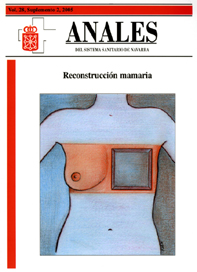Tissue reaction to breast prostheses. Periprosthetic capsular contracture
Keywords:
Prótesis mamarias. Cápsula periprotésica. Contractura capsular.Abstract
Silicone breast prostheses prompt the development of a fibrous casing or periprosthetic capsule. Capsular contracture, due to retraction of the fibrous tissue, is the most frequent and important complication of these implants. It produces varying degrees of hardening and, in advanced cases, deformity of the breast. It has been closely related to the type of surface of the implant (smooth or textured) and with the alignment of the collagen fibers, and it has been suggested that the formation of a continuous capsule, with collagen fibers aligned in parallel and circularly around the smooth prostheses, promotes the development of concentric contractile forces that pulling in unison give rise to contracture. With microporous textured prostheses a significantly lower incidence of capsular contracture has been shown in comparison with smooth prostheses. It is believed that tissue growth within the microporous structure gives rise to multidirectional contractile forces, with a tendency to neutralize one another when their effect is added over the implant. The capsule of these implants presents a base zone composed of multiple layers of collagen fibers aligned in parallel, which might contract. However, the adherence of the microporous textured prostheses might counteract the contractile forces.Downloads
Downloads
Published
How to Cite
Issue
Section
License
La revista Anales del Sistema Sanitario de Navarra es publicada por el Departamento de Salud del Gobierno de Navarra (España), quien conserva los derechos patrimoniales (copyright ) sobre el artículo publicado y favorece y permite la difusión del mismo bajo licencia Creative Commons Reconocimiento-CompartirIgual 4.0 Internacional (CC BY-SA 4.0). Esta licencia permite copiar, usar, difundir, transmitir y exponer públicamente el artículo, siempre que siempre que se cite la autoría y la publicación inicial en Anales del Sistema Sanitario de Navarra, y se distinga la existencia de esta licencia de uso.








